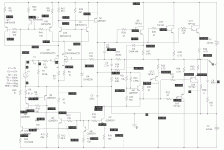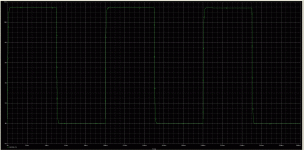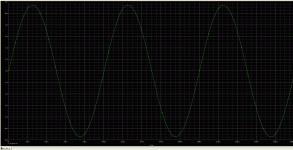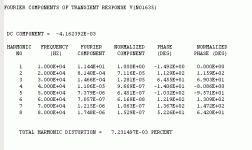Back order doesn't necessarily make it with diy quantities. Why would someone want to wake up their fantastically expensive fab site (face it, all fabs are money sinks that require loads of throughput to make them turn a profit), for something like 142 pieces - that's likely just a pimple on one of their production wafers. For an end-of-life product, orders would probably have to be way in excess of 1k pieces to get anyone interested. I may go with a broker to get what I want, as unfortunately, the TIP142/147 devices I have on hand are from ST - sigh...
Sorry, I mistook the type number for the amount. I found some onsemi TIP142G and TIP147G on E-pay. I'm crossing my fingers as to what I'll actually get, though both are from domestics sellers, and one looks to be a package from Mouser. I've been trying to set up a sim with ZVN3306A in the dricer's seat for input diff stage, and 3 X TIP142 and 147 as outputs. So far, I'm getting 0.04% distortion when I run the sim. I think what I'll need to do is set up the input stage for cascode and augmented bias, as the mosfets need more current to make them light up properly. I also don't know what the models for the Darlingtons are using for bias resistors.
Oh yeah, I actually took a look at onsemi's web site, and the TIP142G and TIP147G appear to both be current devices. However, the usual suspect (Digi-Key and Mouser) don't have much of anything. If you are willing to open up re distributors, there may be a ray of hope. The onsemi web site lists stocking distributors and est. inventory for the 142G and 147G
If you’d rather not wait for stateside stock,
https://export.rsdelivers.com/produ...?cm_mmc=aff2-_-us-_-octopart-_-Instock7743662
https://export.rsdelivers.com/produ...7g-pnp-darlington-transistor-10-a-100/1452831
Found through octopart.com
https://export.rsdelivers.com/produ...?cm_mmc=aff2-_-us-_-octopart-_-Instock7743662
https://export.rsdelivers.com/produ...7g-pnp-darlington-transistor-10-a-100/1452831
Found through octopart.com
2N6287G outputs are discontinued and very hard to find now, at least the ON Semi versions. I repair lots of SAE equipment and used 2N6284G and 2N6287G quite a bit, the 2N6284G is still current but Back Ordered like the rest of the planet. The MJ11015/16G are the next up the line and still current. One of the Forte amps uses the MJH11015/16 plastic versions and is very similar to the A40.
Craig
Craig
The TO-247 versions of the part (MJH6284 and MJH6287) are still current and appear to be in good supply at the usual suspects. They have the 50 ohm driver bias resistor like the TO-3 parts.
I have a pair of the cast aluminum Aussie heat sinks (I forget their name) that might be a shoo-in for the TO-247 parts - they have a nice shelf in the center of the heat sink that looks to be be ok for mount-down. I'll have to take a closer look to see if a pass through a milling machine may provide a better mounting service.
Edit - it's Conrad heat sinks, and I may have the double flange version.
Edit - it's Conrad heat sinks, and I may have the double flange version.
Last edited:
I had a look at the ST version of the 2N6284/2N6287, and they are totally unsuitable for A40 use - the bias resistor values are way too high. They're obsolete,, so it's all academic anyway. Just don't buy 'em as they won't be an adequate substitute for the Motorola/onsemi parts.
Just got a small stash of what purport to be onsemi TIP147G in the mail. The other flavor will arrive when it gets shipped - perhaps the seller is still on Thanksgiving vacation...
I didn't see any reference to NPs parts substitution article for the A40 at First Watt: https://www.firstwatt.com/pdf/art_a40_redux.pdf That's now over 20 years old too, so further updates are a good idea.
OK, I think I have a solution (a solution, not necessarily the solution) - it has more parts, but it allows me to use a hotly biased nmos front end (10 mA/side for more open loop gain) and gets rid of the tantalum cap in the feedback loop. Right now, I'm using TIP142 and TIP147 in the output stage, 3 per side. I would propose using onsemi parts, as they have the nice 40 ohm bias resistor for for the input transistor of the Darlington pair. The response is nice and zippy, with a rise time of around 0.8 us, and is nicely damped. This, at least, is how it plays out in simulation. I would add a bias tweak so I can minimize the output offset. It would be my job to try this thing to see how stable the offset and bias current are over time. Simulated THD is a little bit less compared to the original circuit I simulated, with higher order harmonics (esp. 5th and 7th) gratifyingly low.
OK - Here are the goods, such as they are. The first is the amp schematic simulated in PSpice with 0.5V 10kHz square wave excitation. The second is the square wave response, the third is a blowup of the leading edge. Next is the output with 0.5V sine excitation at 10 kHz, and lastly, the sim distortion profile at 0.5V 10 kHz excitation into an 8 ohm resistive load. The amp is now more complex than the original A40, but the results may be worth the trouble.
Attachments
RS Components is a well-established distributor this side of the pond.Well, the usual caveats would apply re offshore sources., especially if the price appears too good to be true.
They are part of the Farnell / Avnet group. Totally trustworthy.
Jan
Jan, you know precisely which offshore sources I mean - established distributors of repute are not part of the warning...
might as well just directly drive mosfets.
and over bias the same way.
But I will still admit there is something fascinating about
general purpose Darlington's I just love
Tip 142 /47
are basically really slow .5 MHz devices
Just using something simple like the 2N6284/87 or 2N6052/59
creep slightly up to 2 to 4 MHz
New Jersey Semiconductor, Central Semiconductor and OnSemi
still make metal can Darlington's.
Not very rare, it is a 5 dollar general purpose transistor.
pretty easy to find.
6052/59 metal cans can be as low as 2 dollars.
and still faster than TIP's
and over bias the same way.
But I will still admit there is something fascinating about
general purpose Darlington's I just love
Tip 142 /47
are basically really slow .5 MHz devices
Just using something simple like the 2N6284/87 or 2N6052/59
creep slightly up to 2 to 4 MHz
New Jersey Semiconductor, Central Semiconductor and OnSemi
still make metal can Darlington's.
Not very rare, it is a 5 dollar general purpose transistor.
pretty easy to find.
6052/59 metal cans can be as low as 2 dollars.
and still faster than TIP's
If you bite the bullet and transition to discrete Darlingtons, you can use much faster transistors, and as a bonus, tailor the biasing resistors to your satisfaction.
I sharpened my pencil and replaced the hot input nmos inputs with a pair of 2SK170s, biased at ~5 mA/side. THD is a titch higher, (0.008% and change vs. 0.007% and change with the nmos input stage) but the distortion profile is still nice, with 5th and 7th down in the mud like they should be. I also tried some J112s (J113's big brother) in the diff input stage, but the simmed THD went up to about 0.02%, though still with a nice harmonic profile with low 5th and 7th. I suspect the gm of the J112s is not nearly as high as the 2SK170s, even when biased fairly hot.
I may go to Electronic Goldmine and play mix-and-match with some of their NOS Japanese power BJTs. Paired with the TTA004B and TTC004B as drivers, they may make some fast Darlingtons. There are similar fast BJT power devices available at the usual suspects.
I will say, the A40 is nice in that it wrings quite respectable performance out of those slow, slow Darlingtons. I may proceed with just using the onsemi TIP142G and TIP147G as outputs, as this really cuts the parts count as compared to using discrete Darlingtons. I think NP had the right idea is placing his compensation to exclude the output stage. You can see the benefits plainly, even in simulation.
I sharpened my pencil and replaced the hot input nmos inputs with a pair of 2SK170s, biased at ~5 mA/side. THD is a titch higher, (0.008% and change vs. 0.007% and change with the nmos input stage) but the distortion profile is still nice, with 5th and 7th down in the mud like they should be. I also tried some J112s (J113's big brother) in the diff input stage, but the simmed THD went up to about 0.02%, though still with a nice harmonic profile with low 5th and 7th. I suspect the gm of the J112s is not nearly as high as the 2SK170s, even when biased fairly hot.
I may go to Electronic Goldmine and play mix-and-match with some of their NOS Japanese power BJTs. Paired with the TTA004B and TTC004B as drivers, they may make some fast Darlingtons. There are similar fast BJT power devices available at the usual suspects.
I will say, the A40 is nice in that it wrings quite respectable performance out of those slow, slow Darlingtons. I may proceed with just using the onsemi TIP142G and TIP147G as outputs, as this really cuts the parts count as compared to using discrete Darlingtons. I think NP had the right idea is placing his compensation to exclude the output stage. You can see the benefits plainly, even in simulation.
Last edited:
- Home
- Amplifiers
- Pass Labs
- Updated Pass A40 Design




